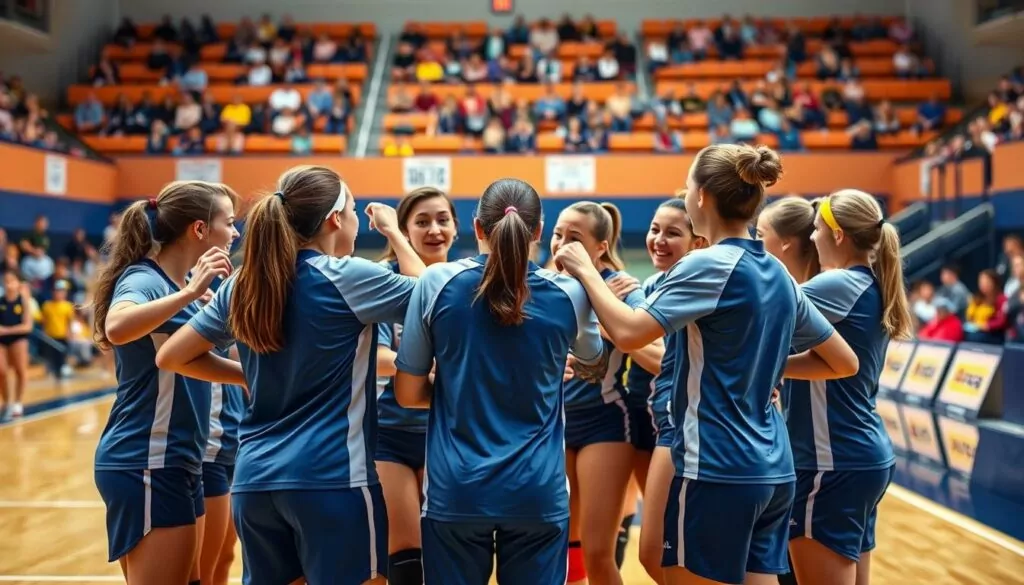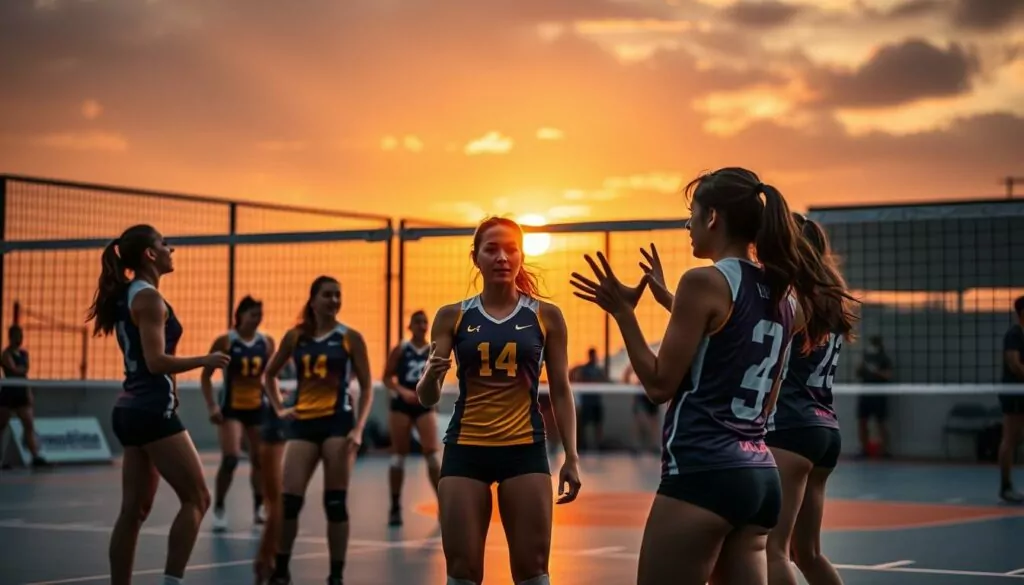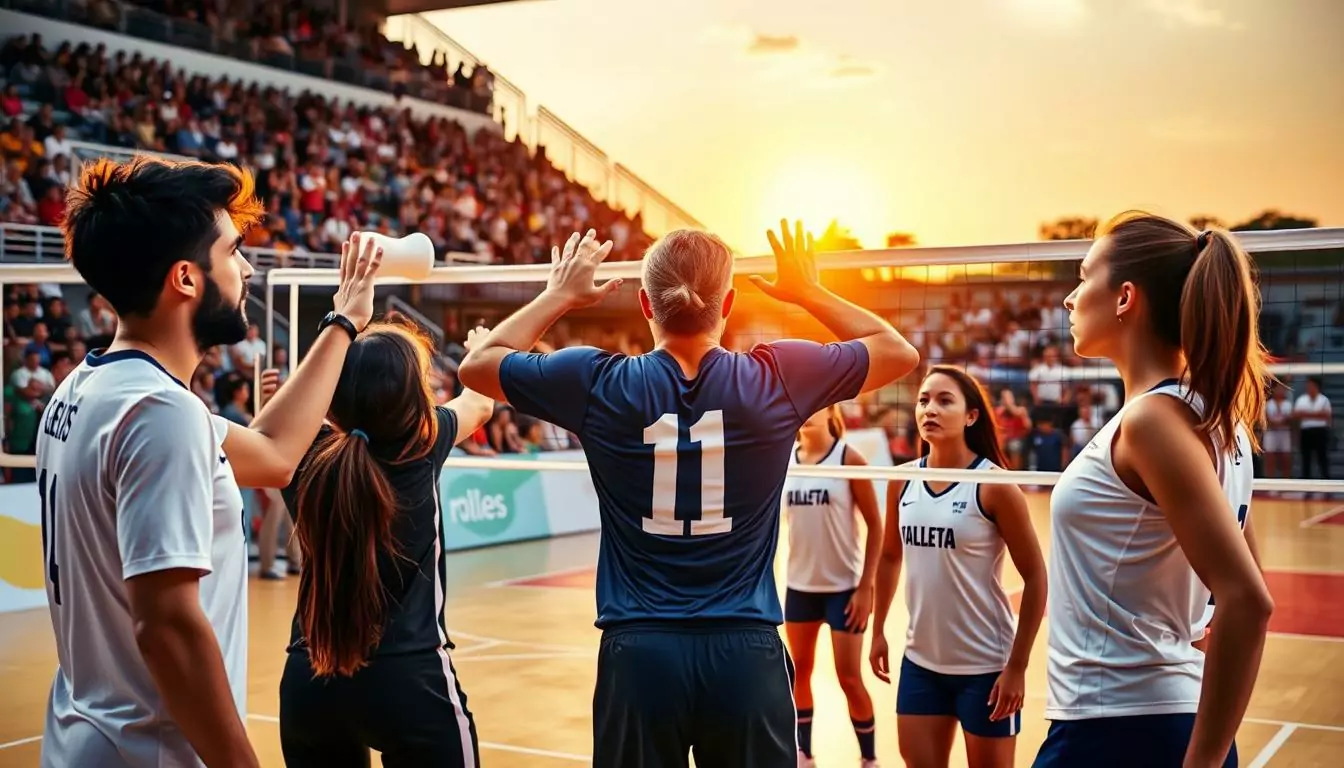I still remember the moment that changed everything for our volleyball team. We were down two sets in a crucial match, and the tension on the court was palpable. As I looked around at my teammates, I saw frustration and doubt in their eyes. That’s when it hit me – we weren’t talking to each other. No calls, no encouragement, just silence. In that instant, I realized the power of communication in volleyball, and how its absence was costing us the game.
This experience taught me that effective volleyball communication strategies are the lifeblood of any successful team. They’re not just about shouting “Mine!” or “Out!” – they’re about creating a dynamic where every player feels connected, informed, and empowered. As we explore these strategies, we’ll uncover how they shape team dynamics and elevate performance to new heights.
From that day forward, our team made a commitment to prioritize communication. We developed a system of clear calls, practiced non-verbal cues, and fostered an environment where open dialogue was encouraged. The transformation was remarkable. Not only did our performance improve, but we also grew closer as a team, supporting each other through every point, set, and match.
Key Takeaways
- Communication is crucial for team success in volleyball
- Effective strategies improve performance and team dynamics
- Clear calls and non-verbal cues are essential
- Open dialogue strengthens team bonds
- Consistent practice of communication skills is key
Why Communication Matters in Volleyball

Communication is the glue that holds a volleyball team together. I’ve seen firsthand how it can make or break a game. It’s not just about shouting “Mine!” when going for a ball. It’s about creating a symphony of voices and actions that lead to victory.
The Impact on Team Performance
Great communication elevates team performance. When players talk, they’re in sync. They know where their teammates are without looking. This leads to fewer mistakes and more successful plays. Coaches give feedback during timeouts, helping the team adjust strategies on the fly.
Building Trust and Cohesion
Trust is built through open communication. When players feel comfortable sharing ideas, they form stronger bonds. This cohesion translates to better on-court chemistry. Leadership roles emerge naturally as players learn to rely on each other’s strengths.
Enhancing Decision-Making Processes
Quick decisions are crucial in volleyball. Effective communication speeds up this process. Players who talk constantly share vital information about the opponent’s movements and weaknesses. This real-time intel allows for split-second adjustments that can turn the tide of a match.
The best teams I’ve coached weren’t always the most talented, but they were always the ones that communicated the best.
Remember, coaching feedback isn’t just for practice. It’s a continuous process that happens before, during, and after games. By fostering strong communication habits, teams create an environment where every player can step into leadership roles when needed.
Key Elements of Effective Communication

In volleyball, mastering communication is crucial for team success. I’ve learned that effective communication involves two key elements: vocal clarity and non-verbal cues. Let’s dive into these essential components.
Clarity in Calls and Signals
Vocal clarity is the foundation of on-court communication. Clear, concise calls help teammates react quickly and make split-second decisions. I’ve found that using short, predetermined phrases works best. For example, yelling “Mine!” or “Out!” leaves no room for misinterpretation.
To improve vocal clarity, I practice projecting my voice during drills. This ensures my calls are heard over crowd noise and other distractions. Remember, it’s not just about volume – enunciation is key.
Understanding Non-Verbal Cues
Non-verbal cues are just as important as vocal communication. Hand signals, eye contact, and body positioning all convey crucial information without a word. I’ve noticed that great players are always aware of their teammates’ positions and movements.
Here’s a quick breakdown of common non-verbal cues in volleyball:
- Pointing: Indicates intended serve or attack direction
- Open palm: Signals readiness to receive a set
- Fist: Shows intention to attack aggressively
- Eye contact: Confirms understanding or requests attention
By mastering these non-verbal cues, I’ve significantly improved my on-court awareness and team coordination. It’s like having a secret language that gives us an edge over opponents.
Developing Communication Skills

I believe that improving communication skills is crucial for any volleyball team’s success. Let’s dive into some practical ways to enhance these skills on and off the court.
Drills to Improve On-Court Communication
One effective drill I use is the “Blind Setter” exercise. The setter wears a blindfold and relies solely on teammates’ calls to set the ball accurately. This drill sharpens verbal cues and builds trust among players.
Encouraging Open Dialogue Among Players
Creating a safe space for players to express their thoughts is vital. I recommend regular team meetings where everyone shares their perspectives. This practice fosters active listening and helps resolve conflicts constructively.
Role of Coaches in Facilitating Communication
As a coach, I focus on teaching huddle techniques that promote quick, effective communication during timeouts. I also model active listening by giving my full attention to players and asking clarifying questions. This approach encourages players to do the same with their teammates.
- Implement communication-focused warm-up routines
- Use role-playing exercises to practice on-court scenarios
- Provide feedback on communication skills during practice sessions
By incorporating these strategies, I’ve seen significant improvements in team cohesion and performance. Remember, effective communication is a skill that requires constant practice and refinement.
Practical Tips for Better Communication
I’ve found that boosting team communication in volleyball is easier than you might think. Let’s dive into some hands-on tips that can make a real difference on the court.
Using Technology to Enhance Team Interaction
In today’s digital age, we can use apps and video tools to our advantage. Team chat groups help us stay connected off-court, while video analysis software lets us review plays and discuss strategies. These tech tools keep us in sync and ready for game day.
Creating a Communication-Friendly Environment
Building a space where everyone feels heard is key. I encourage open dialogues and make sure each player knows their voice matters. This approach fosters positive reinforcement and helps resolve conflicts quickly. When teammates feel comfortable speaking up, our on-court communication soars.
Regular Team Meetings and Feedback Sessions
Setting aside time for team meetings is crucial. We use these sessions to talk about our goals, address any issues, and celebrate our wins. It’s a chance for everyone to give and receive feedback, strengthening our bonds and improving our game plan. By keeping these meetings consistent, we maintain clear lines of communication all season long.
